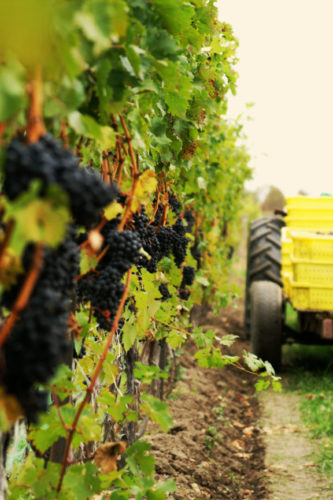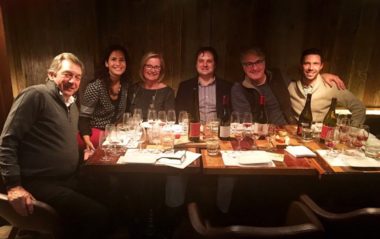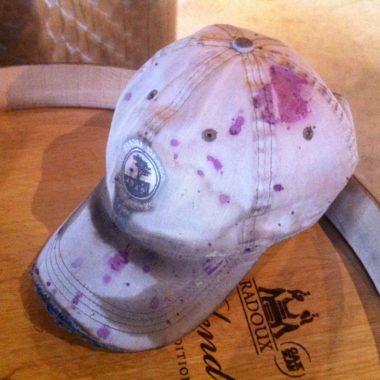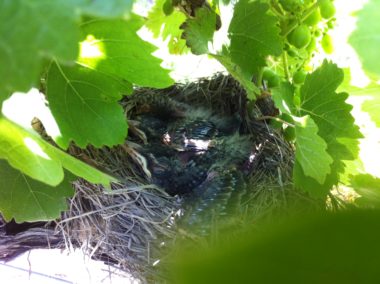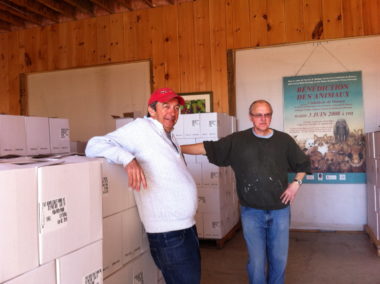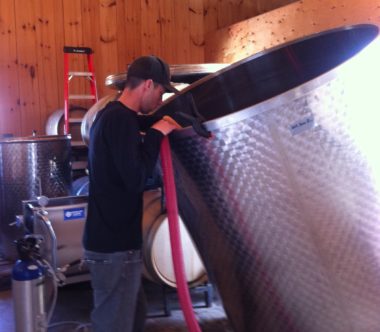The Next Vintage: 2013 Reds
2013 Pinot Noir
In looking back at my harvest notes for the 2013 Pinot Noir, I’m immediately drawn to the “Fruit Condition” section where I have written: excellent; “Some of the nicest we’ve ever picked.” – Wilma. I remember it well, and it makes me smile as much now as it did when she said it on September 18, 2013.
We hand-picked 90 boxes from rows 3, 4 & 5 and 64 boxes from rows 8 & 9. These are the rows that I traditionally use, and they represent a good cross section of terroir from our oldest vines. The Pinot was sorted four times: first I do a quick pass on my own before we harvest to remove any obvious rot; then each picker must inspect clusters as they cut them; a third inspection takes place as boxes are loaded onto the wagon and finally again as they are dumped into the crusher. Those select few Pinot berries that made the final cut ended up filling two fermenting bins.
After a four day cold soak at 18°C, the first bin containing rows 3, 4 & 5 was inoculated with RC212 yeast and the second bin (rows 8 & 9) was inoculated with W15. Fermentation lasted about a week, with peak temperature around 34°C. Wines were then inoculated with malolactic bacteria strain MBR31 and racked to barrel. After 24 months in oak (100% French, 20% new), the wine was blended and eventually bottled on April 6, 2016.
Aromas: “Like walking into a pantry”; ripe cherry, dried spices, truffle
Palate: light velvety texture; good balance; enjoyable now, but just enough tannin to make you want to lay it down for a while
Production: 145 cases
2013 Cabernet Sauvignon
A later Spring than 2012 (few are earlier) led to an interesting vintage that felt like a constant uphill battle. The growing degree days were just not adding up, so an effort was made to dramatically reduce crop level at veraison. Then we waited…and waited some more…until all the leaves had fallen and finally picked our Cab on November 15, 2013.
The fruit was quite desiccated on the vine at this stage, almost a late harvest look, and we actually ended up with close to 23 degrees Brix and reasonable acidity. The drastic thinning gamble had worked, but at the expense of tonnage. We ended up with only 117 picking boxes of Cab Sauv from five rows that would have normally yielded 150 boxes.
The fruit was processed into two bins and after a four day cold soak, Bin 1 was inoculated with FX10 and Bin 2 with F15. Finished wine was blended, inoculated with MBR31 bacteria and racked to barrel where it would spend the next two years. Two new French barrels were used (Taransaud and Billon) along with a couple of wily veterans. The 2013 Cabernet Sauvignon was bottled on April 6th, 2016. This wine will surprise many people.
Aromas: cherry, blackberry, anise, loose-leaf tea
Palate: flavours as intense as the nose; nice texture; savoury; integrated tannins make it both drinkable and cellar-worthy
Production: 100 cases
2013 Syrah
*See 2013 Cabernet Sauvignon for the challenges associated with this growing season.
As we nervously hung our Syrah into November for the first time, I wasn’t sure I’d ever be writing a description for a Five Rows 2013 Syrah – the grapes just didn’t look right. They tasted fine, the lab numbers were good, but the berries looked wrinkled and raisin-like.
A harvest date was finally settled upon, but to our astonishment we awoke that day to….frozen Syrah-sicles! An overnight frost had thrown a wrench into the plans, making for a unique harvesting and de-stemming experience. The stems were so brittle that I was concerned the berries wouldn’t properly separate from the rachis going through the de-stemmer, adding unwanted bits of stem to the must. In the end – I needn’t have fretted, as the semi-frozen berries rattled off the rachis with ease.
82 boxes were harvested from Clone 7 rows 2 & 3, along with 57 boxes from Clone 100 (“Old Block”) rows 1 & 2. The Clone 7 was inoculated with RX60 and the Old Block with F15. Both bins were pressed after a week-long fermentation. The whole batch was aged in French oak; three older barrels and one new (DAMY Rouge).
This wine was incredibly smooth from the get-go, and frankly I have no idea why. Perhaps it was the extended hang time and wilted berries, perhaps it was the frost – yet more proof that the most unique wines often result from unforeseen circumstances. It was bottled on April 6th, 2016.
Aromas: lavender, cassis, vanilla, cooked meat, thyme (“Smells like a lamb dinner” – Wilma)
Palate: smooth as silk, very savoury, hint of pepper, finish dominated by dark fruit
Production: 100 cases
Vineyard of Excellence?
As a general rule, I don’t enjoy being judged. I’d much rather blend into the background like a chameleon and go about my business unnoticed. There are exceptions, however, and when we got the letter that our family vineyard had been nominated for the 2016 Cuvée Vineyard of Excellence award, I realized that the time had come to get over this phobia and submit myself to potential criticism.
The specific block in the spotlight was our Clone 169 Cabernet Sauvignon, located just steps outside the barn door. It was planted in the late 90’s, using “traditional” Lowrey methods: Dad on the tractor and my Mom and I pulled behind on the planter. The Lowrey method relied heavily on the ability of the tractor driver to maintain a straight line, and the jury is still out as to whether Howard Jr. inherited his father’s eagle eye and steady hand. This was before the days of GPS and laser-guided planters – and one look at the hither and yon vine spacing is more than enough evidence of that. It is also worth pointing out that proper and consistent end-post angles were not yet fashionable in the 90’s. You have to remember this was the the decade of frosted tips and crooked posts.
So needless to say, I was greatly relieved to find out that the Award of Excellence was not based solely on aesthetics. An esteemed panel of judges would scout the field at certain points during the season to evaluate vine balance, fruit maturity, disease pressure, crop level, and harvest ripeness parameters. Being a Cab Sauv block, our biggest challenge in Niagara is getting enough heat to ripen the fruit, so I did my best to thin the block to a level that would give each vine a chance to ripen its crop load. Thankfully, the late summer and fall of 2015 provided just the conditions we needed.
When it was announced at the Cuvée ceremony last night that we had, in fact, been named recipients of this award, I was struck with many emotions. To be on the stage with my Dad, being recognized for something that we had done together will be something I never forget. Looking out on the crowd of people, I realized many of them had been directly responsible for my choice of career and it reminded me how fortunate I’ve been to receive their guidance over the years. Perhaps there was also some validation for doing things the old fashioned way – a small vineyard, a father and a son (Lowrey methods notwithstanding).
Dormancy and Dinners
Perhaps the number one thing I look forward to each winter season is the opportunity to participate in a few Winemaker Dinners with my family. When the vines are dormant I tend to be as well, so invitations to be a part of these lavish evenings are received with great joy!
We were very fortunate this year to be featured at a dinner hosted by the Ontario Wine Society (Toronto Chapter) where the theme was a celebration of Lowrey Vineyard Terroir through a comparison of wines made from our fruit. The OWS brought together a wonderful group of winemakers who’ve worked with our grapes over the years – specifically Pinot Noir. The event took place at Barque Butcher Bar and the pairings were facilitated by Michael Godel, who spoke very kindly and shared some flattering observations about our humble little vineyard in St. David’s.
Thomas Bachelder acted as host for the evening and I would’ve been perfectly content to listen to Thomas wax poetic about Terroir and Pinot Noir for the entire night if it was up to me! Ilya Senchuk of Leaning Post Wines also brought some very interesting insight to the Terroir debate, as well as some stellar wines. He pointed out that he sees hallmarks of Lowrey Terroir not only among certain varietals like Pinot, but across varietals as well. We all agreed that there are distinctive elements that define the Lowrey flavour and aromatic profile, as well as textural and mouthfeel similarities. Ilya also noted that as our collective wines age (that is wines made by Bachelder, Five Rows and Leaning Post from Lowrey fruit) the similarities of Terroir tend to become more pronounced. The effect of the winemaker giving way to the effect of Terroir over time is a very interesting concept indeed.
I feel very proud that Mario Adamo thought enough of our Five Rows wines to inquire about purchasing some of our fruit for his own winery venture. The dynamic brother-sister duo of Julie and John Paul Adamo joined us for the evening, and Julie did a great job taking us through their journey to start a winery in the hills of Hockley Valley. It was exciting for me to see what an excellent job they’ve done with the Pinot Noir from our 2008 planting. I see great potential for this block based on their initial efforts, and I highly recommend giving the wines of Adamo Estate Winery a try sometime soon!
Highlights of the dinner were detailed in the latest OWS newsletter and can be read here.
Harvest Musings
As yet another memorable harvest draws to a close, I delight in sharing some of the bizarre things that have crept into my exhausted mind over the last couple of months. It can be a grind at times, so pulling back the curtain a bit to reveal some of the lighter moments keeps me from taking it too seriously.
While conducting a final cull of rotten berries in our original planting of Pinot Noir early in September, I found myself uttering a few choice words at these cursedly tight clusters. It culminated in a rather aggressive flick attempt with my clippers to remove a rotten berry which, in turn, produced a wild spray of acidic juice directly into my face. This moment surely sums up the give and take relationship I have with these old vines, a relationship that began to take human form.
In fact, as I wiped the burning juice from my eyes, I surmised that these five rows are like the brother I never had. We are of similar age (although I am slightly older and wiser) and we have grown up on this farm together. We compete for my parents’ attention and can get very jealous of one another, yet our individual success is completely reliant upon the other. There are epic fights, but if anyone else is critical of my Pinot vines – I’ll kick their ass. We always have each other’s back because our tangled roots run ever deep in this soil.
While pacing around the barn on a weekend that saw a forecasted 15-20mm of rain balloon to a record 86mm, I realized just how tied to the weather my mood becomes during harvest. A rainy day may as well be the end of the world in my mind. Everything is planned around them, you can’t do anything during them, and nothing good ever comes as a result of them! I become consumed with regrets: Should we have picked earlier? Did I just ruin everything good I’ve done all year by letting them hang through a hail storm? How long will this field take to dry out?
Conversely, when the sun is shining – so am I. Strutting around the farm with a wide smile and time enough for everyone, I ooze positivity. It doesn’t get any better than walking through a block of ripe, clean grapes knowing you could pick them whenever you like. I taste each berry thoroughly and make a mental note of which vines and rows will make the cut this year. As you are probably aware, this happens with extreme rarity.
More often I’m faced with a scenario akin to the following: We finish pressing Pinot Noir and I finally have a chance to get out and take a good look at the Riesling. I walk over to the block and think to myself, “Ahh, the patience of Riesling…I can leave them to the end every year and they never let me down!”
It only takes few minutes to realize I’ve waited WAY to long to thin out these vines and now I’ve got a tinderbox of Botrytis on my hands. I flash back to those times during the year when I’d walk by the Riesling and pay them but a fleeting glance before moving on to more pressing concerns. Perhaps I knew deep down that the day of reckoning would come soon enough.
It is reminiscent of a scene from Pee-Wee’s Big Adventure where Pee-Wee is faced with saving all the pets from a burning pet store. Of course he saves the cute puppies and bunnies first, each time running past the terrarium of snakes with a look of terror that I know all too well. The scene ends with a hysterical Pee-Wee running out of the store with fistfuls of snakes and collapsing to the ground.
Before I know it I’m covered in a sticky lather of sweat and juice, hurriedly extricating botrytized clusters of Riesling with my bare hands and high-stepping to the end of the row to hurl them into the headlands…
Crazy, you say?
I know you are, but what am I. (P.W. Herman 1985)
For the Robin in all of us
They are not the most captivating of birds. No one has ever said, “Look at the beautiful Robin, dear!” Up close they look even homelier. I discovered this while thinning Syrah today and abruptly coming face to face with two baby Robins, nestled smack dab in the middle of my vine.
Robins are utilitarian worm hunters. They don’t grace the logo of any sports teams as far as I know – the more popular Blue Jays, Orioles and Cardinals dominate this category. Even the famous “Boy Wonder” was a trusty sidekick at best. You don’t even really notice them until they are looking you directly in the eye. Is this their vine or is it mine?
I make the decision to leave this vine a little “fuller” than I’d like, but any further removal of shoots would compromise their foundation. The obsessive side of me makes a mental note to return to this particular vine later in summer.
Upon further reflection, I feel it appropriate to anoint the unassuming Robin as the official bird of Lowrey Vineyards. Far from flashy, a little rough around the edges, somehow lurking under the radar while in plain sight and then BAM! – Holy Syrah, Batman – all of a sudden we’re right under your nose.
Inspiration
I find it very easy to put off writing when faced with a multitude of vineyard jobs and the constant opportunity to chat with friendly visitors. Interesting topics float in and out of my brain as I squat to carefully tie up the precious suckers offered by winter-ravaged vines of Sauvignon Blanc, but putting wine-stained finger to keyboard seems a chore at the end of a long day.
So why do I feel all charged up tonight? It’s got to be that vineyard green! There is something about the vigour exhibited by grapevines growing in June that gets my blood flowing. Vines that seemed all but dead months ago now brim with green shoots to the point of needing a good thin. I can barely keep up with the growth, but the vines are ahead of schedule and into bloom a full week earlier than the last couple of years. Even the deluge of early June rain can’t dampen my enthusiasm! Anticipation outweighs setback at this stage, as the inevitable diseases have yet to rear their ugly spores (talk to me in a week and I’ll likely be singing a different tune).
There are exceptions – sobering reminders of the harsh winter and a catastrophic worst case scenario that was all too close to becoming reality. Perhaps that is what makes those rare fruit-bearing vines so inspiring. Syrah, Pinot Gris and Sauv Blanc will all likely be 50-75% down in crop level, but thankfully the majority of vines are still alive and throwing suckers. Sourcing fruit from those varieties will be a challenge for all Ontario wineries this vintage.
My current glee could also be traced to a rainy day racking session earlier this week. I was able to get an intimate look at all 2013 and 2014 reds as I siphoned them out of and then back into their cosy oak homes. Some of them were a little unhappy to see me so early, but most were WAY more polished than I anticipated (insert huge exhale here).
It reinforces what I’ve been hearing from visitors to our barn this year: each of our wines has their own distinct personality, and those differences make them interesting and enjoyable. It’s not about vintages being “better” or “worse” than one anther, but rather entirely unique upon comparison. That is an exciting prospect when you find yourself worrying that future wines won’t stack up to the current crowd pleasers. One excited taster recently proclaimed he’d never met a Five Rows wine he didn’t enjoy. The fact that he was my Dad shouldn’t really matter. Tainted praise is still praise to hungry ears.
New Wines and Tag Lines
Each year I struggle to come up with original descriptors for our wines. Each varietal is crafted to best express our terroir, therefore they tend to fit a similar style from vintage to vintage. Tasting notes can sometimes sound like a broken record, so I usually try to make them more story-based.
This year I’ve tried to come up with a phrase or two that might best represent my feelings towards each wine. Keep in mind that I am usually testing the wines when these ideas spring my mind. Here are a few samples from my notebook:
2012 Pinot Noir: Enjoying the many complex layers exhibited by this wine magically erases the emotional scars of growing Pinot Noir. Maybe it’s the resveratrol.
2014 Pinot Gris: Drinking this wine can lead to moments of spontaneous joy and irrational behaviour, like agreeing to adopt a third cat. Drink with caution.
2014 Riesling: This wine is my wife’s favourite, but sadly alcohol makes her sick. Although not sick enough to stop wanting more cats.
2012 Syrah: This wine reminds me why we take the risk to grow Syrah in Ontario. Two rough winters in a row have shaken my conviction at times.
2012 Cabernet Sauvignon: This wine makes me envious of people who grow grapes in California. Not because it’s easier to ripen Cab Sauv there and every year is like 2012, but because they get to live in California!
2014 Sauvignon Blanc: This wine helps cure writer’s block*
*claim pending
For slightly more serious tasting notes click here
Glorious Mud
Being stuck in the mud never felt so good. The usual nuisance of “sinking while pruning” seems a welcome hindrance this year. My smile widens with each heavy step and I can’t help thinking that “thaw” is a beautiful word.
There are many things that signal spring to my internal body clock: bottling new wines, the smell of melted wax and new cardboard, writers cramp, bud counts, the Masters, muddy paws and baseball. Together, they form a complex emotional mix of stress (bottling and dead buds) and thrilling relief (tasting the new wines and the promise of golf season).
April 2nd was my own personal vernal equinox this year, as we bottled all of our new wines (830 cases!) without a hitch. It represents the culmination of three years of work for the 2012 reds and a year for the 2014 whites. Big thanks to all of my helpers, from the case fillers to the bottle dumpers to the humble stackers. I’ve said it before, but my biggest advice to someone starting a mini craft winery like ours would be to find a reliable mobile bottling line. Glenn, Randy and Justin from Hunter Bottling make my life easy on bottling day. The new truck is amazing!
Those who’ve joined our contact list will receive an email in the coming weeks with details of the new release. Our goal is to re-open the barn by May 1st and I can’t wait for everyone to try the new wines!
On Pruning
Most people will never have the opportunity to spend a bitter winter day pruning their way down a row of grapes, so I feel it my duty to inform the masses about this crucial vineyard task.
Every winter, around the beginning of January, my father and I start to get serious about pruning vines in preparation of our next growing season. There is usually a little tire-kicking before we summon enough motivation to begin in earnest, but eventually there is no more time to dawdle. I liken it to that feeling of being comfortable on your couch on a cold day, but knowing you have get up and go to the gym at some point.
The last couple of years have been particularly challenging due to the severe low temperatures and deep snow. The simple act of walking out to the vineyard becomes a production. It goes without saying that proper attire is a must – warm boots and gloves, multiple layers and keeping the wind at your back are keys to stamina. The ‘pruners’ themselves must be well-oiled and sharp (this applies to both physical tool and person).
Sometimes when I’m donning my gear, I summon my inner Han Solo and pretend I’m setting out over the snowy landscape of Hoth, charged with the duty of finding Luke Skywalker and returning him to the Rebel base. This scene from The Empire Strikes Back is as vivid as perhaps any from my childhood, and serves as the catalyst to get me out of the barn and on my way.
As with all vineyard jobs, every vine must be evaluated individually before the cuts can be made. The goal is to whittle it down to four “perfect” canes with roughly ten buds apiece. They must be oriented in such a way that two of them can be tied down in opposite directions along the fruiting wire in the spring (the other two are left untied for insurance). On passing glace it may seem that adjacent vines are very uniform, but this is not the case. There are many subtle differences that must be accounted for: cane diameter, bud spacing, wood density, bud viability, trunk health and residual disease. Leaving the wrong canes can negatively impact the future success of that vine. An experienced pruner can evaluate these variables and make decision cuts in a matter of seconds, spending little more than a minute cleaning up each vine. The anticipation of finding those four perfectly situated canes appeals to my love of solving puzzles.
You eventually settle into a pleasing rhythm of cutting and removing unwanted wood and before you know it you are halfway down the row. Decisions become innate and you are left alone with your thoughts. Welcome distractions like music or talk radio can make time fly, but I caution that waning concentration can be very dangerous. The daydreaming pruner can easily whip themselves in the face with an errant cane (painful and embarrassing), deeply cut a finger (most farmers have done this) or become prey to an overly aggressive coyote (perhaps not as common).
Often I use this time to mentally prepare for the winery jobs at hand. Should I blend a little 2013 with those 2012’s? Do I have enough tank space to rack and blend all my Pinot Noir barrels at once? Is it a good idea to cold stabilize my whites while they are on bentonite? Conveniently, it provides a leisurely way to tackle and think through logistical hurdles.
As the day wears on, it becomes increasingly critical not to let your weak mind slip into thinking about how cold you are becoming, or about the potential implications if all these buds are indeed fried, or if the vine you are pruning might already be dead due to the -23C temperatures sustained last night…
At times like this I usually hop on my trusty Tauntaun and ride back to the Rebel base.
A Treadwell Double Bill
Do you have any plans for the evenings of January 10th or February 7th? I’m hoping that nothing immediately pops to mind and you have the chance to join us at our annual Treadwell Winemaker’s Dinner. These nights have been such a blast over the years that we’ve decided to tack on an encore gig in 2015. Truthfully, the demand for tickets last year caught us a little off guard and we didn’t want to leave anybody out.
The dinners will feature some tantalizing Treadwell dishes paired with our 2011 reds and 2013 whites. I will have to brush up on my knowledge of these wines, as they’ve not been present in our barn for quite a while. I could certainly wax poetic about the freshly fermented 2014 Cab Sauv, but you probably wouldn’t want to drink that one right now. Perhaps I will just wait until the night of the first dinner and we can discover how the wines have evolved together. It’s always more fun to tell old farm stories than bore you with technical wine jargon anyway.
Please visit the Treadwell website for details or call James at 905-934-9797 to book your seat. We hope to see you there!


